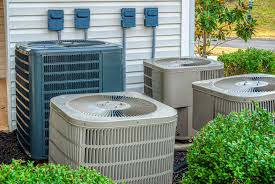Heating, ventilation, and air conditioning (HVAC) systems are essential for year-round comfort in your home. But if your system isn’t running efficiently, it could be quietly draining your wallet. Many homeowners don’t realize just how much energy—and money—is lost due to hidden issues within their HVAC systems.
Christopher Mickey, an experienced HVAC professional and entrepreneur, has seen it all when it comes to home comfort systems. “It’s not always obvious, but the small inefficiencies are what usually cost homeowners the most,” he says. In this article, we’ll uncover some of the most common hidden inefficiencies in HVAC systems and how you can fix them to save money and boost performance.
Leaky Ductwork: The Silent Energy Waster
Your HVAC system relies on a network of ducts to deliver air throughout your home. But if those ducts are leaky or poorly sealed, much of the conditioned air may never reach its intended destination. Instead, it seeps into walls, attics, and crawl spaces, which means your system has to work harder and longer to reach the desired temperature.
In fact, the U.S. Department of Energy estimates that leaky ducts can reduce HVAC efficiency by up to 30%. That’s a lot of wasted energy—and a bigger energy bill.
How to fix it:
Have a professional inspect your ductwork for leaks, holes, or poor connections. Sealing ducts with mastic sealant or metal tape and insulating them in unconditioned spaces can make a noticeable difference in both comfort and energy savings.
Dirty or Clogged Filters: A Common but Costly Problem
Air filters are one of the simplest parts of your HVAC system, but they play a big role in its efficiency. A dirty filter can restrict airflow, forcing your system to work harder and consume more energy. This not only leads to higher utility bills but can also reduce the lifespan of your HVAC equipment.
Many homeowners forget to check or change their filters regularly. Depending on your filter type and household conditions (pets, allergies, dust levels), filters should generally be replaced every 1 to 3 months.
How to fix it:
Set a reminder to check your filters monthly and replace them as needed. Consider upgrading to a high-efficiency filter if indoor air quality is a concern, but make sure it’s compatible with your system.
Poor Insulation and Air Leaks
Even if your HVAC system is in great shape, poor home insulation and air leaks can undo all that good work. If your home isn’t properly sealed, conditioned air escapes and outside air creeps in, making your system run more than necessary.
Common culprits include poorly sealed doors and windows, uninsulated attics, and gaps around plumbing or electrical openings.
How to fix it:
Seal gaps with caulking or weatherstripping, and consider adding insulation to attics and crawl spaces. A home energy audit can help identify problem areas you might not see on your own.
Outdated Thermostats and Controls
An outdated thermostat may not be helping you save energy. Manual thermostats can be inaccurate or hard to manage, and they don’t offer the features that modern systems do to help reduce usage when you’re not home.
Christopher Mickey recommends upgrading to a smart thermostat: “It gives homeowners better control, helps balance comfort with efficiency, and can learn your habits to make smart energy-saving adjustments.”
How to fix it:
Install a programmable or smart thermostat. Many allow you to control settings remotely through your phone and can provide usage reports so you can track your energy consumption.
Lack of Regular Maintenance
Like any major system in your home, your HVAC unit needs regular maintenance to operate efficiently. Without annual checkups, small problems can develop into bigger, more expensive ones. Dirty coils, loose components, or low refrigerant levels can all reduce performance and increase operating costs.
Preventive maintenance also helps identify worn parts before they fail—often at the worst time, like the middle of summer or a cold winter night.
How to fix it:
Schedule professional maintenance twice a year—once in the spring for your AC and once in the fall for your heating system. This ensures your equipment is clean, tuned, and ready for the season ahead.
Short Cycling: A Sign of an Oversized System
Short cycling occurs when your system turns on and off too frequently, often because the unit is too large for your home. While it might sound like a minor issue, short cycling wastes energy, causes uneven temperatures, and adds wear and tear to the system.
Homeowners often assume bigger is better, but that’s not the case with HVAC. A properly sized unit runs longer but more efficiently, maintaining a steady temperature and humidity level.
How to fix it:
If you suspect your system is short cycling, have a professional evaluate the unit’s size relative to your home’s needs. You may benefit from replacing it with a right-sized, more efficient system.
Improperly Placed Outdoor Units
Your outdoor AC unit needs proper airflow to function well. If it’s placed too close to walls, fences, or landscaping, the restricted airflow can reduce efficiency and lead to overheating.
Debris such as leaves or grass clippings can also clog the coils and fan, putting extra strain on the system.
How to fix it:
Make sure there’s at least 2–3 feet of clearance around your outdoor unit. Keep it free of debris and clean the coils periodically. If the placement is severely restricting airflow, you may want to consider having the unit relocated.
Ignoring the Signs of Trouble
Often, homeowners ignore small warning signs like strange noises, inconsistent temperatures, or unusual smells. These symptoms may point to inefficiencies or potential breakdowns that could be fixed early with minor repairs.
Ignoring them doesn’t make them go away. It usually makes them worse—and more expensive.
How to fix it:
Pay attention to changes in how your system runs. If something feels off, don’t wait. Call a trusted HVAC technician to inspect it. Acting early can prevent bigger issues.
Final Thoughts
Hidden inefficiencies in your HVAC system may not always be obvious, but they can be costing you more than you think. From leaky ducts and dirty filters to poor insulation and outdated thermostats, each small issue adds up.
Christopher Mickey emphasizes the importance of staying proactive. “Homeowners who take the time to maintain their systems and make small upgrades usually see lower energy bills, fewer breakdowns, and a more comfortable home overall.”
By identifying and addressing these hidden problems, you can get the most out of your HVAC system—saving money, improving comfort, and extending the life of your equipment. It’s a win-win for your wallet and your well-being.




